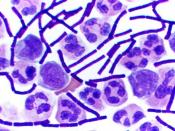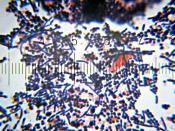It/'s a practical Good and to the point.
Gram Staining to Distinguish Between Different Types of Bacteria
Introduction
Bacteria fall into two natural groups according to their cell wall structure. Some are stained with Gram's stain and are termed Gram positive, others do not retain the stain during the decolourising procedure and are termed Gram negative.
Aim
To test whether B. subtilis and A. tumefaciens are Gram positive or Gram negative using the Gram staining technique.
Apparatus
( Stain: : Crystal Violet solution (0.5% aqueous)
( Mordant : Iodine solution
( Decolouriser : Ethanol 95%
( Counterstain : Safranin solution (1% aqueous)
( Culture of Bacillus Subtilis
( Culture of Argobacterium tumefaciens
( Water bottle
( Wire loop
( Bunsen Burner
( Glass slides
( Paper Tissues
( Microscope
Method
(1) Take a microscope slide and using a dropper place two or three drops of ethanol on the slide. Using a clean tissue wipe the slide.
Replace the dropper in its dropping bottle.
(2) Having put on some safety glasses, light the bunsen burner. Take the wire loop and flame it. After flaming the wire loop, dip it in some of the B. Subtilis culture and spread it on the slide to form a smear.
(3) Holding the slide at one end, invert the slide and the pass the slide through a flame very quickly until the sample is dry. This technique is know as 'heat fixing'. The slide should then be allowed to cool to room temperature.
(4) Next cover the smear with some crystal violet solution. Allow the smear to stain for 1 minute and then rinse with water (from water bottle).
(5) Using the iodine solution, place some drops of it on the smear. Allow this to fix for one minute and then rinse with some water.


